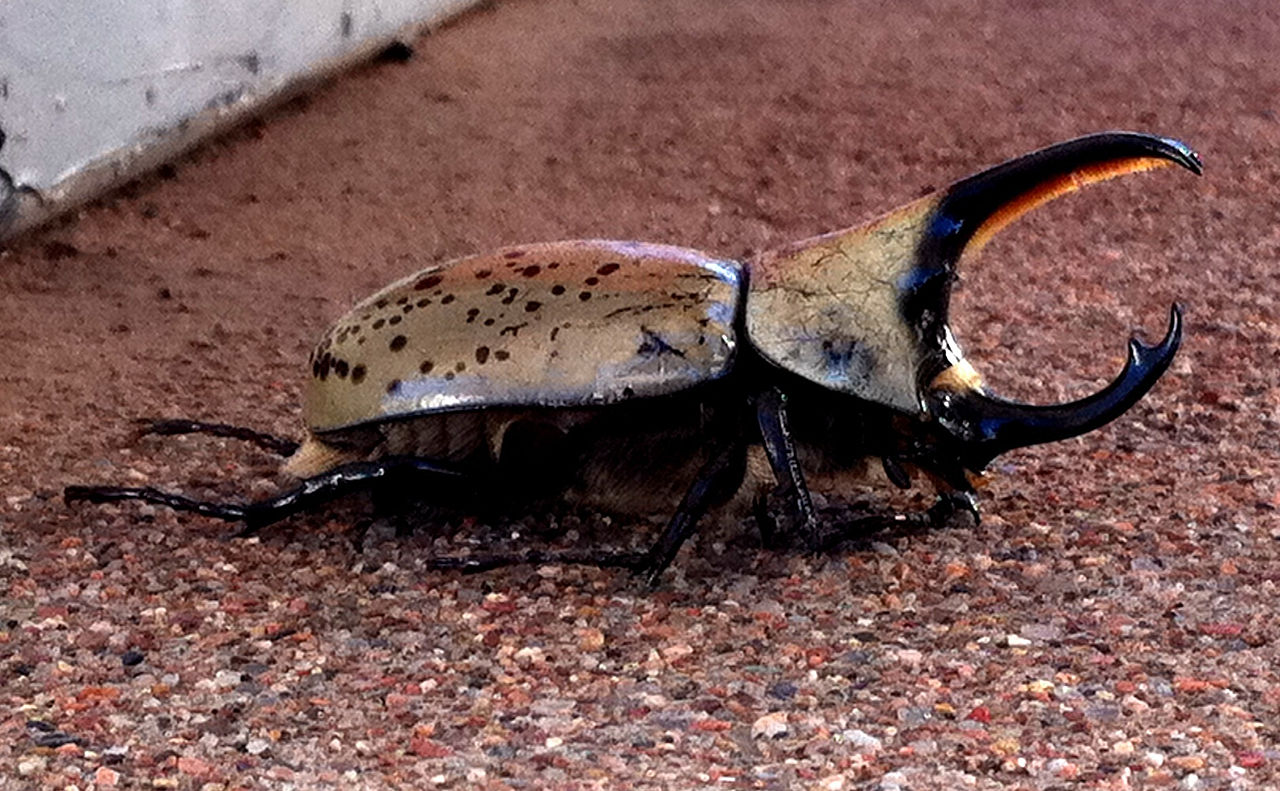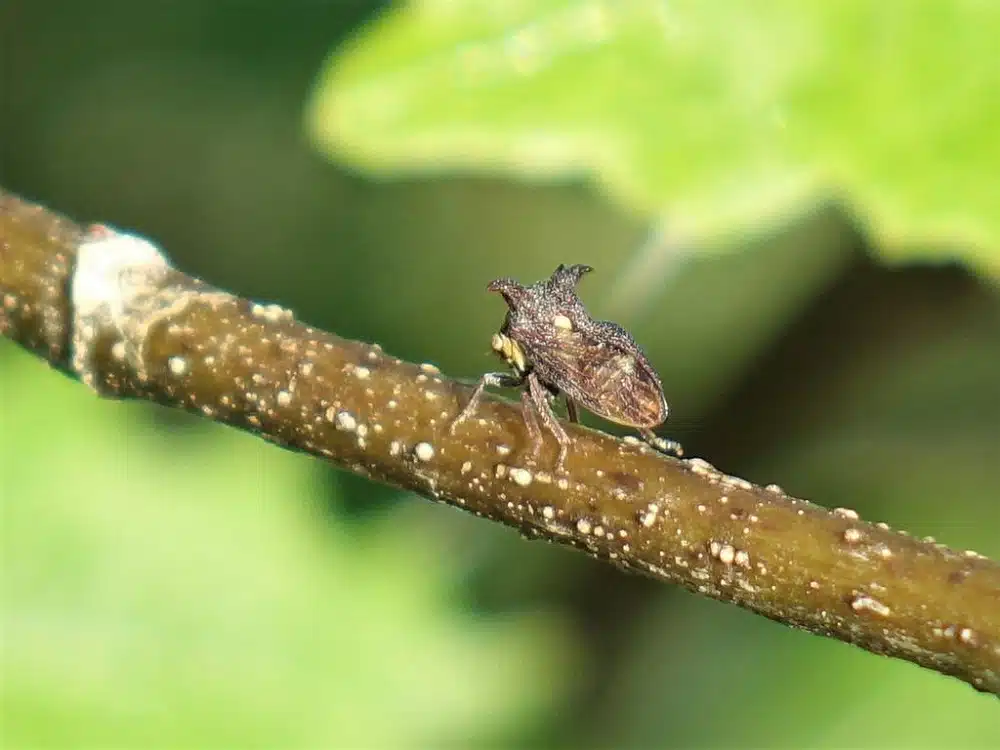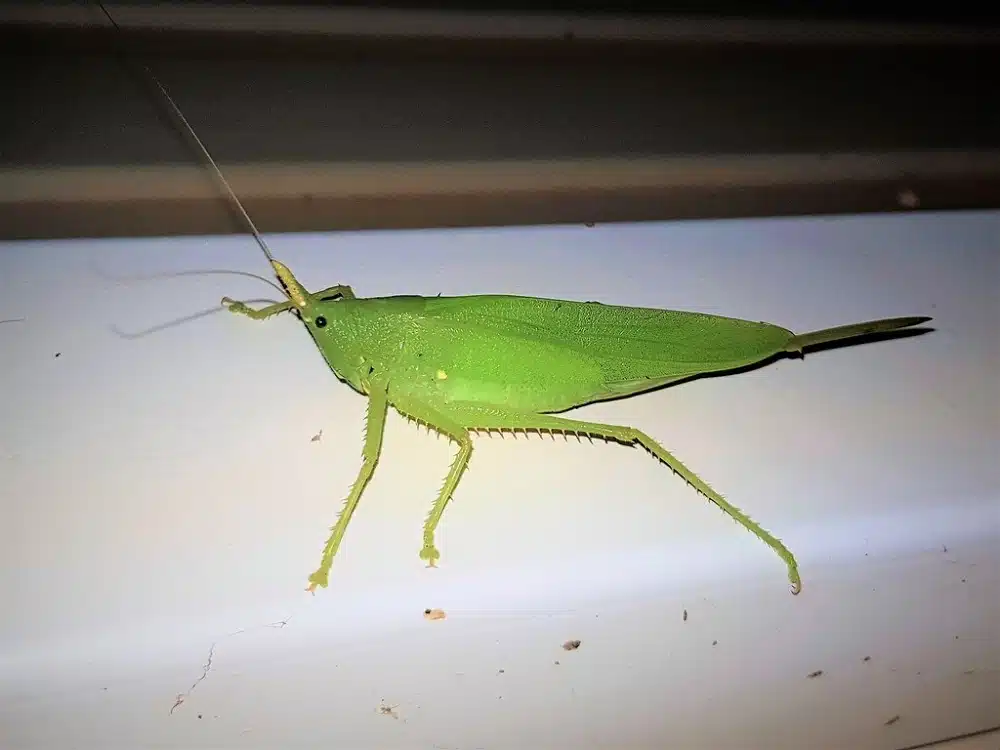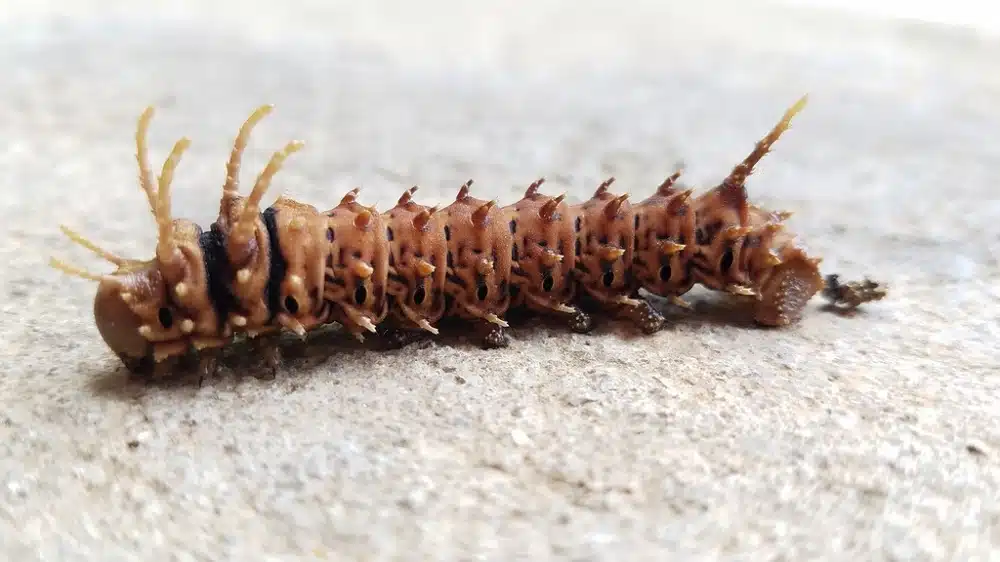Some of the strangest bugs in the world have horns. While they may look like small bulls of the bug world, there are very specific reasons for their horns.
Some of them have to do with aggression. Males use their horns to fight other males.
Other bugs have horns to camouflage themselves or to simply look more threatening to potential predators.
Some of the most intriguing bugs with horns are pictured and described below.
Table of Contents
1. Rainbow Scarab
Rainbow Scarabs (Phanaeus vindex) are some of the most common types of bugs with horns in North America. This is a species mostly found in Texas.
The scarab repurposes animal waste when it comes to its own breeding success.

Using its long horn, the scarab digs under animal waste which is then dragging down tunnels where the females lay eggs.
Animal waste serves as an organic food source for the emerging scarab.
This species of scarab is named after its multicolored appearance. A yellow head and a long black horn are specific to the scarabs which may have green, purple, brown, or other metallic nuances across its body.
The longhorn in the front of the head is slightly curved towards its colorful back.
Number of horns – 1
2. Grant’s Hercules Beetle

One of the common bright types of bugs with horns, Grant’s Hercules Beetle (Dynastes grantii) is a common species in North America.
This beetle feeds on ash trees and can even damage them. It avoids predation by its bright color with or without spots that mimic bright tree bark.
This is a bug with 2 horns. An upper hairy horn is matched with a lower shorter horn on the front of its head.
Bugs of the species are further known for having a white or bright grey color. They mainly are plain colors or show black spots for camouflage.
The long horns of these bugs only grow on males and they take time to grow as the species goes through its development instars.
Number of horns – 2
3. Brown Rhinoceros Beetle

Quite large for a bug, The Brown Rhinoceros Beetle (Xylotrupes Gideon) is a species with 2 horns that bifurcate towards the tips.
Males of the species are larger, growing to a maximum size of almost 3 inches.
Females are smaller, often only about half the size of a male.
These bugs have a red-brown or brown color and may appear to be dangerous. However, the bifurcated horns of the species aren’t really used on humans.
Male Brown Rhinocerous Beetles use their horns against each other when fighting for the attention of females.
Since the tips of the horns are split, they can use them like spoons to flip over their opponent when trying to find a suitable female to breed with.
Number of horns – 2
4. Eastern Hercules Beetle

Eastern Hercules Beetles (Dynastes tityus) are named after their Eastern North America distribution.
This is a type of beetle that feeds on decaying wood and which is only found on decaying wood.
A bright appearance with a tan, off-white, or cream color is specific to these bugs with horns.
Males feature one shorter straight upper horn and one longer upward-facing lower horn.
The rest of the elytra is mostly decorated with black spots.
A species found in forests at high elevations, Eastern Hercules Beetles may also be dark brown, depending on their region.
As with most types of bugs with horns, they use them in aggressive
Number of horns – 2
5. Horned Treehopper
Mostly found in or around woodlands, Horned Treehoppers (Centrotus cornutus) are among the most distinct types of treehoppers.
A short horn is featured at the top of the head of this winged species.
It all has to do with its capacity to stay still and camouflage itself up on trees or plants. When its wings are close together, they form a leaf-like shape.
The horn also looks like part of a leaf and it doesn’t have a role in fighting as with the horns used by horned scarabs to fight.
While dark brown dominated the wings and much of the appearance of this treehopper, its horn is often black.
Number of horns – 1
6. Two-horned Treehopper

Most types of treehoppers with horns have either one horn or a close grouping of 2 horns.
This isn’t the case with the Two-horned Treehoppers (Stictocephala diceros) which have one horn at each side of the head, similar to bulls.
While small, these horns are also believed to help the species camouflage itself in front of all types of predators.
The Two-horned Treehopper is a species that uses hopping for movement, and this can expose it in front of potential threats.
Its reduced size doesn’t help the treehopper either. A maximum size of 0.3 inches is characteristic of this species.
In North America, Two-horned Treehoppers are associated with elderberry.
Number of horns – 2
7. Tri-horned Treehopper

Did you know some types of treehoppers have 3 horns? This is the case of Tri-horned Treehoppers (Acanthuchus trispinifer), a rare species that features not 1, not 2, but 3 horns!
There is a short central horn flanked by 2 longer side horns right at the top of this hopping insect’s head.
Tri-horned Treehoppers are dark brown to black. Their horns are also black and may easily be overlooked.
A species specialized in feeding on plant sap, Tri-horned Treehoppers also consume honeydew.
These jumping horned bugs aren’t predators and don’t use their horns against each other or against other species.
The small green nymph of the species is also known for its long upward-facing tail that may appear like a horn.
Number of horns – 3
8. Notch-horned Cleg

Notch-horned Clegs (Haematopota pluvialis) are some of the most dangerous types of biting flies as they make no sound when flying.
Other types of flies such as horse flies signal their presence with a buzzing flying sound, which isn’t the case with Notch-horned Clegs.
This is a species that may look like having horns as well. Females have elongated mouthparts which can be perceived as a single long horn.
They require a blood meal to lay eggs and are very good at creeping quickly around an animal or even around humans for a biting meal.
These types of biting flies can be found almost everywhere but they prefer shaded locations as they don’t like living in the sun.
Number of horns – 1
9. Horned Leafhopper

Oak trees are the main host of Horned Leafhoppers (Ledra aurita). These types of jumpers are only found in Europe and Asia.
Their most atypical physical trait? A short curved horn at the top of the head points forward.
Its horned back allows the species to seem like part of a twig or as part of the bark it rests on to predators.
A light brown color is mostly specific to Horned Leafhoppers. This is also a species that comes in green colors with or without transparent wings.
Its horn is purely ornamental as it helps it resemble real leaves it fees on.
This is one of the main species that feeds on leaves but it doesn’t have a deadly impact on plants such as other types of bugs.
Number of horns – 1
10. Eggplant Horned Planthopper

One of the planthoppers with the longest horns and one of the bugs with the longest horns in relation to its body is the Eggplant Horned Planthopper (Leptocentrus taurus).
This species has a long horn that’s curved back and runs parallel to its body and even runs as long as its body.
This is a species with a long black horn which may help its protection against predators.
Yellow-brown wings are specific to this plant-eating bug in contrast with its black horn.
Its eyes are orange or orange-brown and also stand out in relation to its coloring.
Some morphs of the species are mostly dark brown and black. All of its morphs are small as Eggplant Horned Planthoppers grow to a size of up to 0.2 inches.
Number of horns – 1
11. Horned Conehead

Horned Coneheads (Copiphora cornuta) stand out with their small yellow horns. They are differently colored compared to the rest of the bug which is green.
The horn of the species is believed to be an adaptation to its environment.
Horned Coneheads are mostly bright green. Their wings are green with red-brown margins while their head is also green with a yellow horn and a yellow margin.
The horn of the species is pointy and facing upwards, also helping the species move about in its natural range.
Horned Coneheads also have long tails that are almost twice as long as their leaf-like bodies.
Number of horns – 1
12. Horned Isopod

A species found along beaches, Horned Isopods (Deto echinata) come with 2 small horns at the back of their heads plus an additional row of 12 horns or projections from head to tail.
Both males and females have a pair of horns but they aren’t specifically known to rely on them for aggression as they don’t fight each other.
These dark bugs are found in areas with plenty of organic material buildup.
Algae and washed-up wood on beaches represent the main food of Horned Isopods.
Number of horns – 14
13. Regal Moth Caterpillar

Not all bugs such as beetles have horns. Some caterpillars are also known for having at least a pair of horns.
This is the case of The Regal Moth Caterpillar (Citheronia regalis). These types of caterpillars show multiple types of horns, of different sizes and colors.
The horns on the head or just behind the head are the longest. A red nuance with a black tip is specific to these long horns.
Arranged in rows, the long horns on the head are followed by a series of short black horns along the body.
Again, these are all short black horns with the exception of a final red and black horn.
These spiny horns are aimed to deter predators from this bright green caterpillar.
14. Pine-Devil Moth Caterpillar

A species that eventually becomes brown, just like adult moths, this type of caterpillar (Citheronia sepulcralis) is also horned.
It features multiple types of long and short horns across its dorsum. Some of the longest horns on the species are those located on the head while those further down its body are short.
The long horns of the species are pointy but they can’t be used in fighting as they’re purely decorative and aimed at increasing its chances of scaring away predators.
This caterpillar also has a brown appearance which resembles a dying leaf to further improve its camouflage.
Pine-Devil Moth Caterpillars are native to the Eastern US states.
15. Tomato Hornworm

Some caterpillars don’t have rows or even pairs of horns.
Tomato Hornworm caterpillars (Manduca quinquemaculata) have a singular red horn at the rear end. This horn cannot be used in fighting as the caterpillar moves slowly with its prolegs.
It can’t even be used against other caterpillars as the species isn’t aggressive.
This sole horn has the purpose of sacring predators away and to potentially drive them away before they get in trouble.
Additionally, Tomato Hornworm caterpillars also show small eyespots to seem like another species. These blue and black eyespots are located on the sides of the body.
16. Saddleback Caterpillar

It seems that everything about the appearance of Saddleback Caterpillars (Acharia stimulea) is aimed at driving predators away.
This species has multiple horns across its body. Furthermore, their horns are covered in spines which may induce rashes if handled with bare hands.
The caterpillar has black horns but the spines on them are red so that they look more dangerous.
A green saddle-like pattern is further distinguished on its back. This makes the caterpillar look like a different species and not a caterpillar at all.
Unlike other caterpillars, Saddleback Caterpillars can use their horns and spines.
They try to curl up in a ball so that there’s no exposed area of the body when under threat. Many predators retreat in this situation.